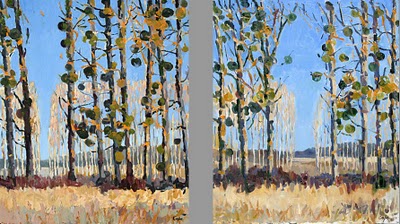Ditypch
Oil on two canvas
each 64 x 55 cm (approx 21,5 x 25 inches)
© adam cope
“Here, by the riverside, the motifs multiply, the same subject seen from different angle offers a subject for study of the greatest interest, and so varied that iI think I can keep myself busy for months without shifting my position, inclining sometimes more to the right, sometimes more to the left.” – Cézanne, to his son Paul, Aix, sept 8 1906
Here’s a reference photo, at dusk, as I imagine there’s possibly a few of you who might not know what misteltoe looks like (it’s the round clumps in the trees).
Mistletoe is a parasitic shrubs that grows in trees, living of the host-tree’s sap. Mysterious plant I love it & have four clumps in my garden. We used to celebrate New Year with it in my southern english home town of Winchester.
“Mistletoe bears fruit at the time of the Winter Solstice, the birth of the new year, and may have been used in solstitial rites in Druidic Britain as a symbol of immortality. In Celtic mythology and in druid rituals, it was considered a remedy for barrenness in animals and an antidote to poison[11], although the fruits of many mistletoes are actually poisonous if ingested as they contain viscotoxins.” Mistletoe-WIKI



